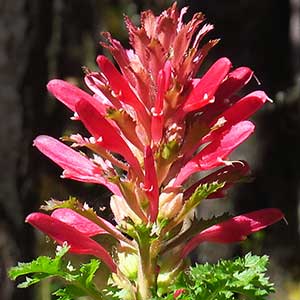Pedicularis densiflora
Pedicularis lanceolata
Indian warrior, warrior's plume
swamp lousewort
basal 1–10, blade lanceolate, 30–200 x 20–70 mm, 2(or 3)-pinnatifid, margins of adjacent lobes nonoverlapping or extensively overlapping distally, 1-serrate, surfaces glabrous, hispid, or downy;
cauline 4–20, blade lanceolate, 15–250 x 5–100 mm, 2-pinnatifid, margins of adjacent lobes nonoverlapping or extensively overlapping distally, serrate, surfaces glabrous, hispid, or downy.
basal 0;
cauline 10–30, blade lanceolate, 20–100 x 10–30 mm, 1-pinnatifid, margins of adjacent lobes nonoverlapping, 2-serrate, surfaces hispid.
simple, 1–5, exceeding basal leaves, each 10–50-flowered;
bracts lanceolate to trullate, 10–35 x 3–5 mm, undivided or 1-pinnatifid, proximal margins entire, distal 1- or 2-serrate, surfaces glabrous.
paniculate, 1, each 10–20-flowered;
bracts lanceolate to trullate, 5–10 x 3–5 mm, undivided or 1-pinnatifid and 1- or 2-auricled, proximal margins entire, distal 1- or 2-serrate, surfaces glabrous or hispid.
2–4 mm.
1–1.5 mm.
calyx 9–18 mm, downy to tomentose, lobes 5, triangular, 3–4 mm, apex entire, ciliate;
corolla 23–43 mm, tube dark red, purple, or orange-yellow, rarely white, 8–18 mm;
galea dark red, purple, or orange-yellow, rarely white, 15–25 mm, beakless, margins entire medially and distally, apex straight;
abaxial lip dark red, purple, or orange-yellow, rarely white, 8–15 mm.
calyx 7–12 mm, glabrous or hispid, lobes 2, trullate, ovate, elliptic, or triangular, 2.5–3.5 mm, apex serrate, glabrous, sometimes ciliate;
corolla 16–22 mm, tube white, cream, or light yellow, 8–12 mm;
galea white, cream, or light yellow, 8–12 mm, beaked, beak straight, 0.5–2.5 mm, margins entire medially and distally, apex extending over abaxial lip;
abaxial lip white, cream, or light yellow, 7–10 mm.
= 16.
= 16.
Pedicularis densiflora
Pedicularis lanceolata
Scarlet corollas with an undomed, toothless galea and two- or three-pinnatifid leaves are diagnostic of Pedicularis densiflora. This species occurs in forested subalpine regions of southern Oregon, western slopes of the Sierra Nevada, and the Coast Ranges of California south to Baja California. Herbarium records indicate northern populations of P. densiflora occur at higher elevations than do more southern populations.
(Discussion copyrighted by Flora of North America; reprinted with permission.)
The long corolla tubes of Pedicularis lanceolata are uncharacteristically nectarless, and only late season pollen-foraging worker bumblebees pollinate this species (L. W. Macior 1969). The uniquely hinged abaxial lip covering the opening of the galea is an adaptation to allow only worker bumblebees access to the anthers, as they must learn to push it aside during foraging.
(Discussion copyrighted by Flora of North America; reprinted with permission.)


